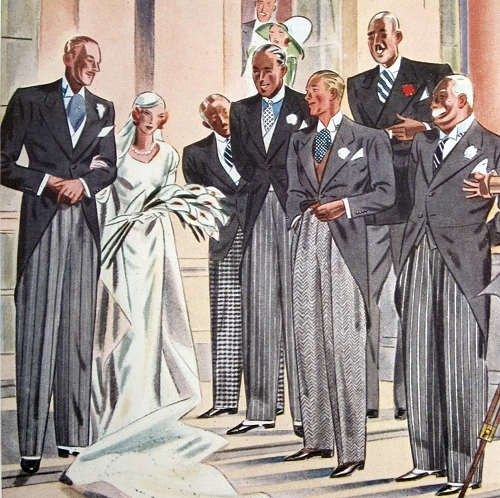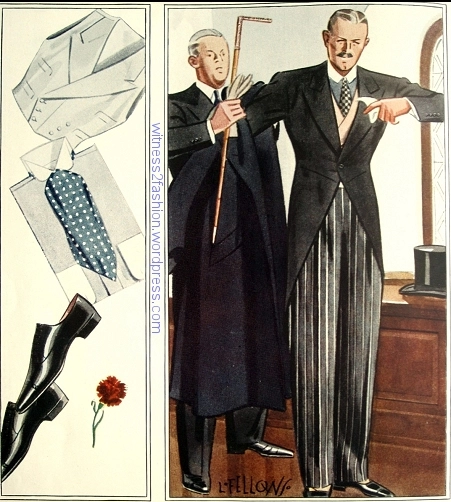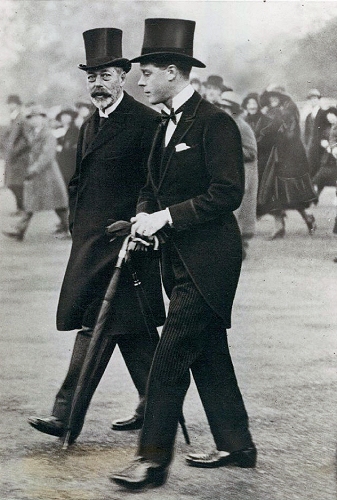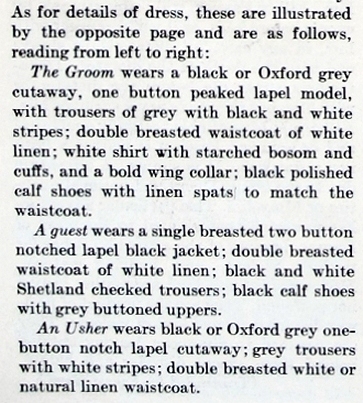
Formal Wedding Party, Daytime Wedding, Esquire, June 1934. Pg. 139.

The “morning coat”, or “cutaway” is the most formal daytime outfit for men. “Morning coat” refers to the entire outfit, which includes striped trousers and a vest, etc. Esquire magazine, April, 1934, p. 126.
In the Spring and Summer of 1934, Esquire magazine ran several articles about wearing the morning coat. The morning coat, or “cutaway” had long been a correct choice for formal daytime events, but in 1936, by royal decree, it officially replaced the “frock coat” as formal daytime clothing in the English court. (I found this date in Diana de Marly’s book, Fashion for Men. )
In the early 20th century, in spite of the acceptance of sack suits for most business purposes. . .

What sack suits looked like by 1934. Double breasted or single breasted, they were standard business clothing. Esquire, Feb. 1934.
. . . the frock coat was still correct formal daytime wear for diplomats and other men for whom a casual appearance was not acceptable.
A little background on the frock coat:

Queen Victoria and Prince Albert, 1861. He wears a frock coat, vest and trousers. Photo by Mayall, courtesy of V and A Museum.
The frock coat — and the man’s three piece suit — can be said to have originated with Charles II of England, who abolished the clothing worn at the French court . . .

A French courtier, 1660, from costumer Nicole Kipar’s archives.
and commanded, in 1666, that the more manly “Persian” suit of clothes be worn in his presence. Eventually, the combination of knee length coat, breeches, and vest evolved into normal business wear for men. The 19th century frock coat really did resemble the full-skirted dresses of the 1820’s and 30s….

Frock coat in French Fashion Plate, 1829. Courtesy of V and A Museum

Frock coats, 1828, Journal des Dames. Thanks to TwoNerdyHistoryGirls for finding this plate.

Young lady with gentleman in Frock coat, London, 1861. Courtesy V & A Museum.
The photo below, from the early 20th century, shows the King of England, George V (at left), wearing a frock coat, which he favored for official daytime menswear. It was worn by lawyers, bankers, and other successful men, not just at court. He is with his son, Prince Edward (b. 1894, later the Duke of Windsor), who is wearing a formal black or dark gray cutaway.

Left, King George V in frock coat; right, Edward, Prince of Wales, wearing a cutaway or morning coat. Photo: Flash and Footl
During the few months when he was king — before abdicating — Edward, who really preferred to wear a sack suit, abolished the frock coat at court in favor of the cutaway, or morning coat. By the 1930s, the bands of braid on the cutaway had disappeared. (Around the turn of the century a cutaway could be part of a casual three piece suit.)
During the early 1930’s, Esquire treated its readers to at least two articles about the morning coat — timed for the Summer wedding season. (On June 3, 1937, Edward, now the Duke of Windsor, was married — appropriately, in a morning suit.)
This ad from men’s clothier Rogers Peet shows attire for a wedding:

Rogers Peet ad for menswear. Esquire, April 1934. (The curvature of the page distorts it.)

Esquire, April 1934, p. 126.

The Floorwalker at a posh department store. While handing an elderly lady her package, he says, “–and think of us when you think of panties.” Esquire, April 1934, p. 32.
Esquire felt obliged to explain that — even though classy store employees wore them — there really was justification for a gentleman to buy a set of morning clothes.

Reasons to own a morning suit, Esquire, April 1934.

“Morning coat” refers to the entire outfit, which includes striped trousers and a vest, etc. Esquire magazine, April, 1934, p. 126. Illustration by Fellows.


Esquire morning coat article, April 1934.

In June, Esquire spelled out the groom’s obligations regarding gifts to the ushers, flowers, and how to avoid blunders when dressing for a formal daytime wedding — with many choices of gray, white, or natural linen waistcoat, and a variety of collars and ties.

Wedding Etiquette and Dress Article by Stuart Howe, Esquire, June 1934.

Illustration accompanying Esquire’s June article on clothes for a formal wedding, p. 139.

Which man wears wears what at a formal daytime wedding. Article from Esquire, June 1934. Pg. 138.
I believe that the man with a mustache, standing left of the bride, and wearing a white vest and stiff wing-collar shirt, is the groom, partly because his boutonniere is lily of the valley, rather than a white carnation or gardenia.

The groom is responsible for flowers worn by the ushers, et al. Esquire, June 1934, pg. 138.

Gifts from the groom to the ushers, et al. Esquire, June 1934, pg. 138.

Waistcoats/vests to wear to a wedding with your cutaway or morning coat. Esquire, June 1934. p. 138.

Wedding guest in cutway coat,with spats over his shoes. Ad for Talon zippers, Esquire, April, 1934.
The wedding party wears spats, too:

Groom, bride, guest (in checked trousers & shoes with light colored tops). An usher in white-striped trousers. Is that the best man wearing herringbone trousers and a wing-collared shirt? Esquire doesn’t mention him. I think the father of the bride is the beaming man with white hair and two-button cutaway; the man in the blazer, solid gray trousers, and red carnation is presumably a guest, not part of the wedding party. Esquire, June 1934. Pg. 139.
For the man whose social schedule did not include participating in the Easter Parade, attending Royal Ascot or signing treaties, there was another occasion, besides weddings, when a morning coat could be worn:

Cartoon by Hoff, Esquire, June 1924.
There is an excellent history of the morning coat at the Morning Dress Guide blog, with the added advantage of a European point of view (and photo collection) from its author, Sven Raphael Schneider.
Even in the thirties, when many men owned a tuxedo to wear to dances, nightclubs, dinners, concerts, and the theatre, morning dress was more likely to be rented than purchased, in spite of Esquire‘s advice.
P.S. What would costumers do without Stacy Adams shoes? This company still sells black shoes with white tops, although they have snaps, rather than buttons…. The Gentleman’s Emporium has a surprisingly wide selection of spats.

Fascinating! I’m especially interested to see natural linen as a choice for a formal waistcoat. In the 18th century, natural linen was regarded as suitable only for underwear or clothing for the lower classes. In the 19th century, it could be fashionable for somewhat casual clothing in the warm weather. Here you have shown, in the 1930s, less than a century later, natural linen suitable for the most formal of occasions. And now, in the 21st century, linen is still something of a luxury fiber.
I’m not sure if there was a direct reference to natural linen when I showed some 1930’s dinner jackets, but I was interested to see that the “white dinner jacket” was often a natural, not stark white, color. I think I used “natural” to mean the color, rather than a literal reference to “natural linen” in that post (It could be that Esquire did the same.). When Esquire showed a fabric sample cut into the shape of a jacket, there was no text describing it. But that natural linen waistcoat on the ushers would be another example of the way mens’ sporting clothes evolve into formal dress.
That is an interesting reference to an usher wearing a natural linen waistcoat. The fashion for a white or coloured waistcoat is attributed to Prince of Wales and that fashion caught on in North America.